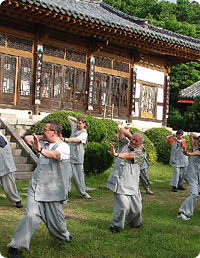SPECIAL INTEREST
Two Wheels Plus 14 days
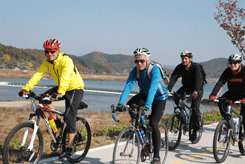
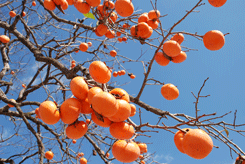
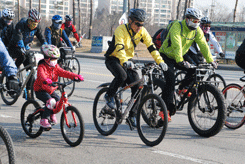
Tour Highlights
- Gyeongbokgung Palace
- National Folk Museum of Korea
- Insadong
- Namdaemun Market
- Silleuksa Temple
- Juangangtop Tower
- Hahoemaeul Village
- Andong Folk Museum
- Gyeongju National Museum
- Donggung palace and Wolji pond
- Banwolseong Fortress
- Cheomseongdae Astronomical Observatory
- Tumuli Park
- Bulguksa Temple
- Seokguram Grotto
- Haeundae Beach
- UN Memorial Cemetery
- Yongdusan Park
- Jagalchi Fish Market
Tips on Korean names
Expressway - 고속국도
National Road - 국도
Provincial Road - 지방도
City. County Road - 시. 군도
Other Road - 기타도로
Railroad - 철도
Bike Lane, Bike Path, Bikeway - 자전거도로
Sharp curve - 급커브
Steep gradient - 급경사
Usually named with following Korean suffixes stand for
Ro (로) - Road or Street
Daero (대로) - Main Street or Thoroughfare
Gil (길) - Road or Street
Ri (리) - Village
Maeul (마을) - Village
Dong (동) - Administrative unit in the city or village
Myeon (면) - Small County
Eup (읍) - Large County
Gun (군) - Administrative unit covering Myeon and Eup
Si (시) - City
Do (도) - Province
Cheong (청) - Office of Gun, Si or Do
Samuso (사무소) - Office
Samgeori (삼거리) - Fork or Junction
T Junction (T자형 삼거리)
Gyocharo (교차로) - Crossroads or Intersection
Sageori (사거리) - Crossroads or Intersection
Negeori (네거리) - Crossroads or Intersection
Nadeulmok (나들목) - Interchange
Gyo (교) - Bridge
Daegyo (대교) - Long Bridge
Yeok (역) - Subway station, Railroad station
Tunnel (터널) - Tunnel
Jihado (지하도) - Underpass
Guldari (굴다리) - Underpass
Jae (재) - Pass or Hill
Ryeong (령) - Mountain pass
Road signs are almost always in English as well as Hangeul.
Language is less of a problem than it might seem - many people understand some English.
Riding on any of the major roads can be physically and mentally exhausting and frustrating, traffic in general has little respect for your cycling plight.
Accommodation in motels or pensions is ubiquitous, standard and economical.
Vegetarian menus in some restaurants are rare to find.
Tour from April through October |
| Tour facts and features | |
| Accommodation | 14 hotel and pension nights in 2 and 4 star twin share accommodation |
| Meals | 11 breakfasts |
| Transport | All transportation by private vehicle, and speed train |
| Guided | Services of an English speaking guide |
| Group size | Maximum 9 |
| Age range | 18+ |
| Activity | Cycling of 9 days |
| Degrees of difficulty | Difficult |
Note |
Click on the days to access the programs quick
| Days | Visits and Activities | Distance |
| Day 1 | Arrive Seoul | 60km |
| Day 2 | Seoul | |
| Day 3 | Seoul - Yeoju | 100km |
| Day 4 | Yeoju - Chungju - Suanbo | 84km |
| Day 5 | Suanbo - Mungyeong | 52km |
| Day 6 | Mungyeong - Andong | 88km |
| Day 7 | Andong | |
| Day 8 | Andong - Hahoe - Yonggi | 76km |
| Day 9 | Yonggi - Yeongcheon - Gyeongju | 128km |
| Day 10 | Gyeongju | |
| Day 11 | Gyeongju - Busan | 110km |
| Day 12 | Busan | |
| Day 13 | Busan - Seoul | 450km |
| Day 14 | Departure | 60km |
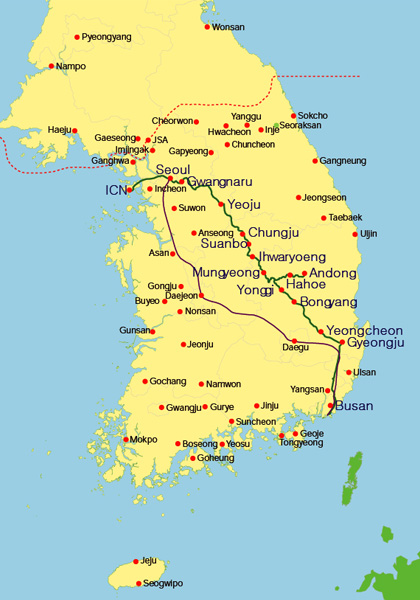 Day 1 Arrive Seoul (- - -)
Day 1 Arrive Seoul (- - -)
60km
Touching down at Incheon International Airport places you in the heart of Korea. After you clear Passport and Customs control, you will be welcomed by the tour guide and then transferred to your hotel.
Upon check in, pick up your bike and time for fitting.
Pedals, cleats, cycling shoes, crank arm length, saddle selection, height, fore/aft and tilt, handlebars, brake levers, etc.
A proper bike fit is essential so that you can produce the most power, most efficiently, meaning you have a position on the bike that lets you ride as long as you want, and stay comfortable the entire time.
The evening is yours to relax, allowing your mind and body time to adjust to different time zone.
Day 2 Seoul (B)
Your exploration this morning begins with a driving tour of Seoul, featuring sites such as Seoul Plaza, City Hall, Cheonggye Square and pedestrian-friendly Gwanghwamun Plaza that is hemmed in on both sides by rushing traffic and office buildings. The plaza is lined on each side with 365m long streamlets, two centimeters deep and one meter across, the stone bed of the plaza's east side waterway engraved with important events in chronological order from 1392 to 2008.
Step back in time to when life was gracefully slow and discover Gyeongbokgung Palace, a particularly charming spot that represents a colorful and turbulent side of the capital's 500-year history. Depending on timing, you may witness the Royal Guard Changing Ceremony featuring parade, password verification, duty shift and patrolling the gate. Accompanied by a court band with its colorful costumes and royal flags, the ceremony is performed daily basis at 10:00 and 14:00 except Tuesdays, although it is cancelled in case of rain or extremely hot or cold weather.
Your visit to the National Folk Museum of Korea will familiarize you with wealthy culture of this friendly and picturesque nation. It is an excellent facility to illustrate the history of traditional life of the Korean people from the prehistoric age to the Joseon dynasty. The permanent exhibition features life and work, costumes and ornaments, handicrafts and technology, educations, living quarters, dietary life, oriental medicine, performing arts and games, beliefs and rituals, and
socio cultural life.
Insadong, at one time the center of traditional Korean art and antiques, features a mixture of historical and modern atmosphere representing the cultural glimpse of the nation. Clustered along the main street and alleys are lined with street vendors, wooden tea houses, restaurants and numerous galleries and shops dealing in antiques, oriental art supplies, and modern Korean art of all types and styles. Soak in the paintings, upscale artworks, antiques and potteries while you can. Get lucky and you just might meet the artist themselves. It can be plenty of fun walking on the main street, but you venture into the hidden alleys that do spring some unexpected surprises. While here, you may want to buy some souvenirs or simply wander and browse at leisure admiring cultural ambience.
You will tour the centuries-old Namdaemun Market brimming with well over 11,000 shops selling anything you can imagine. One of the most colorful aspects of the market is an endless sprawl of street-vendor stalls that setup in the alleys and walkways between the buildings. The market is seriously crowded, so be prepared to get bumped around. A fantastic place to haggle over the price to get the best deal on something you want or simply admire the vibrancy of this massive market.
At the western entrance of the market in the middle of a traffic circle stands Sungnyemun. It is a formidable and iconic construct that served as the southern gate of the wall that surrounded Seoul during the period of the Joseon Dynasty.
Day 3 Seoul - Gwangnaru Park - Paldang - Yeoju (B) 100km
The Four Rivers Cross Country Cycling Trail goes where the rivers go. One of the most famous challenge is the cross-country haul from Seoul to Busan for 633 kilometres, consisting of four connected cycle paths known as the Ara, Hangang, SaeJae, and Nakdonggang pathways. The routes are mostly level but in Saejae sector the routes travel through two steep climbs, but traffic is very light. Keep in mind that you and automobiles are not the only ones using the roadways. Your responsibility is to know how to safely share the road with others from people to animals to other types of vehicles.
Today, you take Hangang sector. Your first day of cycling roughly break into two parts; from your hotel to Gwangnaru Park on a supporting vehicle (20km) to avoid heavy traffic and frustration navigating the way onto the riverside cycle path. And from Gwangnaru Park to Yeoju (80km) is on a bike. Though, English signs are rare to find, the bikeways are well established and marked properly for any to follow. The bikeways with lot of flat and rolling are suitable for fit bikers with basic skills. Bike paths are separated from vehicles but not from pedestrians walkers, runners or in-line skaters. As such, not for professional races or intense competition.
While in Yeoju, explore Silleuksa from the Silla dynasty (BC 57-AD 935). It is a rare temple that is perched on a riverbank amid an attractive waterfront whose cove forms a snug and cosy enclosure for this ancient sanctuary. Many pray at a beautiful seven-tier marble pagoda, that is masterfully adorned with dragon and lotus carvings. Incense burning in the temple and sights and smells mixed offer visitors a really magical experience. A 500-year-old aromatic juniper tree and a 600-year-old ginkgo tree grow on the temple grounds, and on a small hill stands a seven-story brick pagoda, the only existing Goryeo brick pagoda (918-1392).
Day 4 Yeoju - Chungju - Suanbo (B) 84km
The riding of the day is relatively easy. Make your way along the river to Chungju. The trails are still flat and scenery is beautiful. Out in the countryside, apple orchards are more visiable. Chungju has an outstanding cultural background with a traditional martial art known as Taekgyeon and a traditional musical instrument, Gayageum from the 7th century. Enjoy a short stop at a 7-story Jungangtap Park, and Tangeumdae where the celebrated musician, Ureuk used to played Gayageum.
Suanbo is a small town harbouring a large number of hot springs.
Soaking in the soothing warm waters and relax.
Day 5 Suanbo - Sojoryeong - Ihwaryeong - Mungyeong (- - -) 52km
The day is truly challenging. No bikeways but more hassle over the route navigation. Down to Mungyeon is a variety of steep downhill curves, back roads, river banks, farm roads, village roads and paved trails that can be strung together for an esthetically enjoyable bike ride.
As you reach Eunhaengjeong Gyocharo (은행정교차로), the elevation gets higher to the top of Sojoryeong then gentle downhill to Haengchongyocharo (행촌교차로). Take an Ihwaryeongro (이화령로) that goes under the brige. At the top of Ihwaryeong pass (548m), a spectacular view of the valley below and a stamp await you. The downhill from Ihwaryeong is steep and winding at every turn. About 600m down from the village, turn left through underpass then turn right using the second farthest road from the underpass. Do not take the first one that is for incoming vehicles. Note no traffic lights here. Extreme caution is required as always, but particularly from Gakseori to Mungyeong Pottery Museum for 1.5km. At the base of the road from Ihwalyeong Pass is Jinanri village (진안리), there is a ceramic museum with elegant pieces and informative explanation. Shortly after rushing traffic road, bikeway goes on the riverbank crossing a number of bridges, and finally to Mungyeong.
Day 6 Mungyeong - Andong (- - -) 88km
The bikeways are mostly built along the riparian area, so the riding is down stream to Sangpunggyo bridge (상풍교), the confluence of Nakdong river. As you cross the bridge, your riding goes very gentle upstream to Andong, a stronghold of Confucianism in Korea which has deeply influenced the lives of Koreans in all aspects.
Day 7 Andong (B)
The day is relatively relaxing, however you may want to tour Andong on a bike. Visit Andong Folk Museum offering in-depth information of traditional life and illustrating traditional Confucian culture. The museum exhibits a variety of legacies relating mainly to four cardinal ceremonies, coming of an age, wedding, funeral, ancestral memorial service, as well as dozens of pieces of pottery, utensils, clothing, farming tools and traditional folk games in small models.
Enjoy the local ambience exploring the market selling a wide array of merchandises, vegetables, fishes and fruits. At the one end of the market is an alley specializing in braised chicken. It’s savory, mildly salty and sweet with a very subtle spicy kick. Perhaps you may want to try it. The neighboring blocks are filled with fancy stores, cafes and restaurants. The atmosphere are very welcoming.
There is a Confucian Land that offers a chance to experience the culture of Confucianism. Overall 15km riding covers them all.
Day 8 Andong - Haheo - Yonggi (B) 76km
Biking on the same route back you took to explore UNESCO World Heritage Site, Hahoemaul from the 15th century. It is the best preserved traditional village portraying and spanning the life of the Joseon Dynasty (1392-1910) and some 480 Korean traditional houses, both large and small, are still fully functioning. As you take a walk in the narrow alleys, enjoy the rustic and old charm of this unique village. You cannot possibly miss a 600-years old zelkova tree, the home to the village spirit. At the tree's base is where residents still make their wishes. The village is also known for traditional festival, Hahoe Mask Dance which gave common people the opportunity to mock those in authority, and in particular the Byeolsingut, a shaman ritual exorcising evil spirits, dating back to the Goryeo dynasty (918-1392). With time to visit, continue your way Yonggi (45km). Following the road to Yonggok Samgeori (용곡삼거리), take Road 923 with less vehicular traffic all the way to Yonggi (용기) for 25km.
Day 9 Yonggi - Yeongcheon - Gyeongju (- - -) 128km
The journey continues to Jarakri passing Gyochon Gyocharo (교촌교차로). Gangbyeonro road about 4km ahead leads you to Hwajeonri (화전리). At road end, cross the street and after about 1.5km thrilling ride on a speeding Gyeongbukdaero (경북대로), jump on Road 927 at Gumisamgeori (구미삼거리) and then merge Road 28 about 10km ahead. Stay on this road until you reach Ubo middle school (우보중학교) where you join the road that is crossing railroad 100m ahead to your right. The biking path and railroad goes to Yeongcheon side by side.
Riding past Sinnyeong post office, police station and Sinnyeong station (신녕역). About 200m from the station, take a narrow road running on the right side of the main road. Make a left turn for Yeongcheon at the Sindeokhyocharo (신덕교차로) about 600m At Seomunyukgeori (서문육거리), take Undongjang-ro on your left leading to Yeoncheon sports complex. On arrival at this complex, your biking adventure wrapped up, and then on to Gyeongju on a vehicle.
Today, you are treated to one of the ten most historically significant sites in the world with ancient temples, weathered stone pagodas, royal tombs, Buddhist bas-reliefs, and fortress ruins.
En route, tour the Tomb of King Muyeol (603-661). Presided over the golden age of Silla expansion, King Muyeol forged an alliance with Tang China and defeated the rival Baekje kingdom with the help of Kim Yusin. The tomb is a circular ground mound made of piled-up soil with a bottom girth of 116m, and a height of 8.8m. Near the base of the mound are ring of stones which were possibly used in protecting an underground structure, but most have disappeared over the centuries while only the larger stones remain. Behind the king's tomb are four giant mounds that are believed to hold the remains of relatives of the king. A famous turtle base with tablet cap-stone that dates from the original construction is on display and you will not miss it.
And discover the 7th century Bunhwangsa temple with 10m-high three-storied rectangular pagoda, the main worship hall with Buddha of Medicine, and legendary well that is said to have saved the kingdom. The nearby open field was once occupied by Silla's largest temple Hwangyongsa. The 67m tall nine-storied pagoda made entirely of wood stood here until it was destroyed during the Mongol invasion in 1238.
Day 10 Gyeongju (B)
With a full day to further explore the delights of UNESCO World Heritage Site on a bike. At Bulguksa, you will witness the impressive gates, symbolic bridges leading up to the world of Buddha, graceful architectures, Three-storied Seokgatap and highly ornate Dabotap blending well into the architectural harmony.
At Gwaneumjeon hall, check out the image of the Avalokitesvara who is referred to as the Bodhisattva of Compassion and has a thousand hands, and eyes in each so as to reach out to those in need of help. You will see a gilded statue of Vairocana with the gesture of the first wisdom, Sakyamuni Buddha along with sixteen figures of Buddha's disciples sitting in deep meditation, and a gilt-bronze Amitabha Buddha who is the ruler of the Western Paradise Sukhavati. The architectural design of Bulguksa is one of constrained dignity, peace, and harmony and the temple still remains one of the most remarkable achievements of the ancient Far East.
Visit UNESCO World Heritage Site, Seokguram grotto. It is the home of the serene stone Buddha of the eighth century. Inside, a white statue of a seated Buddha in a sublime state of enlightenment, is surrounded by 37 relief figures of Bodhisattvas, disciples, devas, and guardian kings. The grotto represents the magnificent harmony of religion, science and the arts of Buddhism, symbolizing the pure land in which Buddha resides.
Gyeongju National Museum offers a great insight into Silla culture and history. The first thing that you will notice is The Bell of King Seongdeok, the largest extant bell in Korea. You must certainly stand in awe before the bell from the 8th century with such artistic beauty of design. The bell is distinguished not only for its outstanding beauty but also for its long reverberating sound, the incredibly precise casting technique, in addition to the sad legend surrounding it. On entering the museum, you will marvel at the priceless archaeological and historical artifacts including splendid gold crowns, earrings, belts, ornaments, glassware, potteries, and clay figures as well as a royal barge.
Then, check out the world's oldest existing astronomical observatory, Cheomseongdae. Each stone used in the observatory bears symbolic meaning; the same number of the days of the year by lunar calendar, the number of the major stars, the months of the year and the numbers of the seasonal divisions. Nearby Tumuli Park encompasses 23 huge tomb mounds where Silla rulers were buried. One of the tombs, Cheonmachong, is opened to the public and you can go inside and see how the tombs were made and replicas of the treasures excavated in 1973. The Gyeongju Historic Areas contain a remarkable concentration of outstanding examples of Korean Buddhist art, in the form of sculptures, reliefs, pagodas, and the remains of temples and palaces from the flowering, in particular between the 7th and 10th centuries, of this form of unique artistic expression.
Day 11 Gyeongju - Busan (B) 110km
Your journey cotninues to Busan, Korea's second largest city surrounded by the ocean on one side, and mountains on the other. Its deep harbor and gentle tides have allowed it to grow into the largest port in Korea and the fifth largest in the world. It is also a center of industry and commerce, a thriving metropolis formed unusually long in shape along its coastal line.
Enjoy a short break at Haeundae, a world-class beach resort blessed by beautiful water and screened by skyscrapers along the beautifully curved coastline. Afterward, cross the Suyeong Bay over Gwangan Bridge, installed with over 10,000 colorful LED lights which sparkle brightly under the night skies.
Visit UN memorial cemetery where 2,334 deceased soldiers from fourteen Korean War allies rest in honored serenity. Learn about the Korean War and pay tribute to those who dedicated their lives to the World Peace. During the period of 1951-1954, remains of approximately 11,000 fallen of the UN Forces were buried here. Thereafter, most were repatriated to their home countries. In the cemetery, lie the remains of Korean War heroes from Australia(281), Belgium(1), Canada(382), Colombia(4), France(47), Netherlands(124), New Zealand(32), Norway(1), Republic of Korea(39), South Africa(11), Thailand(1), Turkiye(462), United Kingdom(892), United States of America(41) Unknown and others(16).
You will tour Yongdusan Park where Busan Tower sits atop a hillock of a steep slope, affording 360-degree views of the hilly terrain of this mountainous coastal city and the harbor. Smack dab in the middle of the park stands the statue of Yi Sunsin, who is credited with the perfection of the first iron-clad warship in history. You will also see a flower clock and a Busan citizen's bell that they ring on New Years' Day, March 1 and August 15.
Just off the park is Gwangbokro Street, full of shops selling everything from bargains to luxury items. Adjacent is a maze of small streets alive with color, sidewalks sprinkled with unique shops and local eateries. Enjoy the vibrant ambience as you leisurely make your way to the BIFF square, Busan’s modern movie district having hand prints of the famous movie stars and directors on the sidewalk, movie theaters, trendy shops and street food stalls. The area with originally little more than a pair of cinemas that were built over half a century ago had turned into the newly transformed district, and was named BIFF Square on August 14, 1996.
Across the street from the square is a fascinating Jagalchi fish market, a great attraction located dockside. Here you will find a diverse array of seafood on display as you walk along the narrow alleys of street vendors. A nearby indoor market features live fish in the tanks and the upstairs are dried fish along with many restaurants selling raw fish at reasonable prices. The market is really a visual and culinary treat.
Day 12 Busan (B)
Day at leisure. You can explore the city yourself or simply relax. The are several beaches, one of which is Haeundae, a world-class beach resort blessed by beautiful water and screened by skyscrapers along the beautifully curved coastline.
Day 13 Busan - Seoul (B) 450km
Following hearty breakfast, return on a high speed train to Seoul. The remainder of the day is yours to spend at leisure.
Day 14 Departure (B) 60km
After this wonderful trip exploring Korea and with time to reflect on your surprise in your experience, you will return to the airport in time for your flight. By boarding, you are already high above Incheon heading for home.





